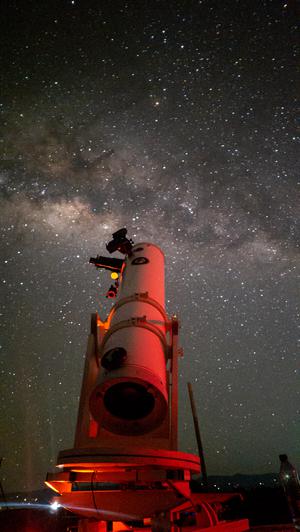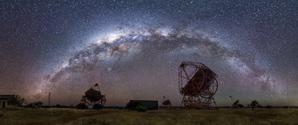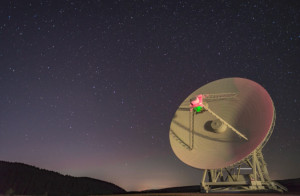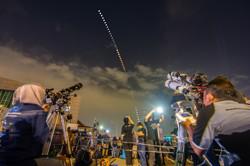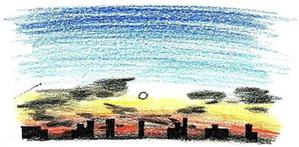Glossarbegriffe: Beobachtung
Description: Bei astronomischen Beobachtungen werden elektromagnetische Strahlung, Teilchen oder Gravitationswellen, die uns von einem astronomischen Objekt erreichen, gesammelt und/oder gemessen. Früher haben Menschen mit ihrem bloßem Auge den Himmel beobachtet. Ab dem frühen 16. Jahrhundert gibt es Teleskope für astronomische Beobachtungen. Heute können dafür eine Vielzahl von Kameras, Spektrometern und anderen Instrumenten genutzt werden. Die gesammelten Informationen, wie z. B. die unbearbeitete Bilddatei, welche uns eine Kamera liefert, werden als (Beobachtungs-)Daten bezeichnet.
Diese Daten enthalten Informationen über das Objekt und das dazwischenliegende Medium (z. B. das interstellare oder intergalaktische Medium), hängen aber auch von den Besonderheiten des Instruments ab, z. B. wenn ein Teil der Kamera empfindlicher ist als ein anderer. Die Daten hängen auch von Verunreinigungen ab. Wenn wir beispielsweise Licht von einem astronomischen Objekt mit einer Kamera sammeln, nehmen wir normalerweise auch Vordergrundlicht mit auf, das in der Erdatmosphäre gestreut wird. Die möglichst vollständige Entfernung von instrumentenspezifischen und verunreinigenden Anteilen in den Rohdaten wird als Datenreduktion bezeichnet. Typische Endprodukte von Beobachtungen sind Bilder, Spektren und Zeitreihen (wiederholte Beobachtungen desselben Objekts oder derselben Objekte, z. B. Daten von Pulsaren oder veränderlichen Sternen). Solche Beobachtungen können verwendet werden, um verschiedene Größen zu messen, z. B. den Winkel zwischen zwei Objekten, die Zeit, zu der ein Ereignis beobachtet wurde, oder die scheinbare Helligkeit eines Objekts.
Beobachtungen unterscheiden sich von den Experimenten, die in vielen wissenschaftlichen Labors durchgeführt werden, dadurch, dass der Beobachter nicht mit den astronomischen Objekten selbst interagieren kann, wie es ein Chemiker kann, der zwei Chemikalien mischt. Manchmal können astronomische Beobachtungen aber durch Experimente an den Objekten selbst ergänzt werden, z. B. bei der Untersuchung von Meteoriten oder indem Raumsonden zu Himmelskörpern im Sonnensystem reisen.
Zugehörige Glossarbegriffe:
- Scheinbare Helligkeit
- Elektromagnetische Strahlung
- Observatorium
- Teilchen
- Spektrum
- Gravitationswellen
- Veränderlicher Stern
See this term in other languages
Term and definition status: The original definition of this term in English have been approved by a research astronomer and a teacher The translation of this term and its definition is still awaiting approval
The OAE Multilingual Glossary is a project of the IAU Office of Astronomy for Education (OAE) in collaboration with the IAU Office of Astronomy Outreach (OAO). The terms and definitions were chosen, written and reviewed by a collective effort from the OAE, the OAE Centers and Nodes, the OAE National Astronomy Education Coordinators (NAECs) and other volunteers. You can find a full list of credits here. All glossary terms and their definitions are released under a Creative Commons CC BY-4.0 license and should be credited to "IAU OAE".
If you notice a factual or translation error in this glossary term or definition then please get in touch.
Zugehörige Medien
Learning Nights
Bildnachweis: Juan Pablo Botero Londoño/IAU OAE (CC BY 4.0)
License: CC-BY-4.0 Creative Commons Namensnennung 4.0 International (CC BY 4.0) icons
Milky Way Over H.E.S.S Observatory
Bildnachweis: Jianfeng Dai/IAU OAE (CC BY 4.0)
License: CC-BY-4.0 Creative Commons Namensnennung 4.0 International (CC BY 4.0) icons
Southern Sky Over La Silla
Bildnachweis: José Rodrigues/IAU OAE (CC BY 4.0)
License: CC-BY-4.0 Creative Commons Namensnennung 4.0 International (CC BY 4.0) icons
The Big Dipper with the Sardinia Radio Telescope SRT
Bildnachweis: Antonio Finazzi/IAU OAE (CC BY 4.0)
License: CC-BY-4.0 Creative Commons Namensnennung 4.0 International (CC BY 4.0) icons
The Eclipse Between Us, by Muhammad Rayhan, Indonesia
Bildnachweis: Muhammad Rayhan/IAU OAE
License: CC-BY-4.0 Creative Commons Namensnennung 4.0 International (CC BY 4.0) icons
Related Activities
Build a Safe Sun Viewer
astroEDU educational activity (links to astroEDU website) Description: Build a safe Sun viewer using cheap household items and learn why it is dangerous to look directly at the Sun, even briefly.
License: CC-BY-4.0 Creative Commons Namensnennung 4.0 International (CC BY 4.0) icons
Tags:
Hands-on
, Safety
Age Ranges:
6-8
, 8-10
, 10-12
Education Level:
Primary
, Secondary
Areas of Learning:
Modelling
, Observation based
Costs:
Low Cost
Group Size:
Group
Skills:
Planning and carrying out investigations
Street Lights as Standard Candles
astroEDU educational activity (links to astroEDU website) Description: Understand astronomical distances using street lights
License: CC-BY-4.0 Creative Commons Namensnennung 4.0 International (CC BY 4.0) icons
Tags:
Hands-on
, Distances
, Distance measurements
, Inverse square law
Age Ranges:
14-16
, 16-19
, 19+
Education Level:
Informal
, Secondary
, University
Areas of Learning:
Modelling
, Structured-inquiry learning
, Technology-based
Costs:
Low Cost
Duration:
3 hours
Group Size:
Group
Skills:
Analysing and interpreting data
, Constructing explanations
, Developing and using models
, Planning and carrying out investigations
, Using mathematics and computational thinking
Evening Sky Watching for Students
astroEDU educational activity (links to astroEDU website) Description: Let's observe the evening sky with the naked eye
License: CC-BY-4.0 Creative Commons Namensnennung 4.0 International (CC BY 4.0) icons
Tags:
Art
, Observation of sky
, Sky watching
, Motion of star
Age Ranges:
4-6
, 6-8
Education Level:
Pre-school
, Primary
Areas of Learning:
Discussion Groups
, Observation based
, Social Research
Costs:
Free
Duration:
30 mins
Group Size:
Group
Skills:
Asking questions
, Communicating information
